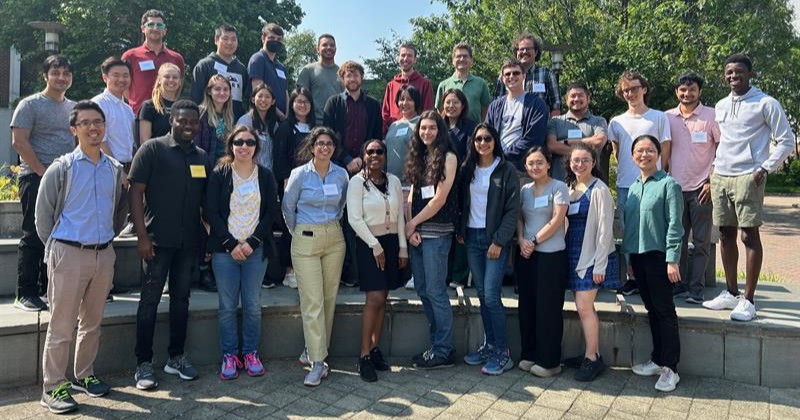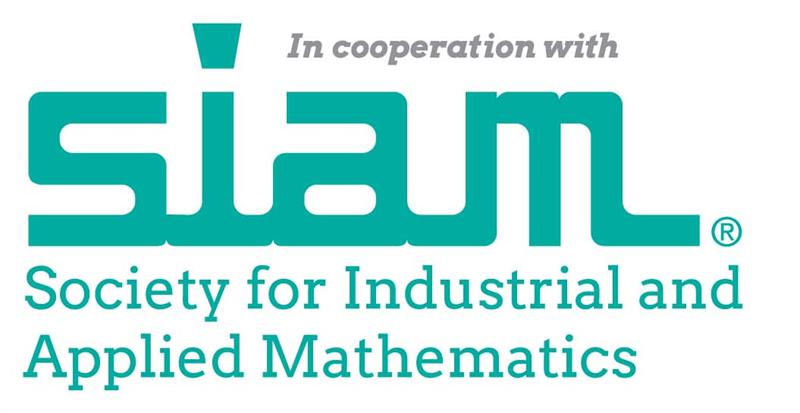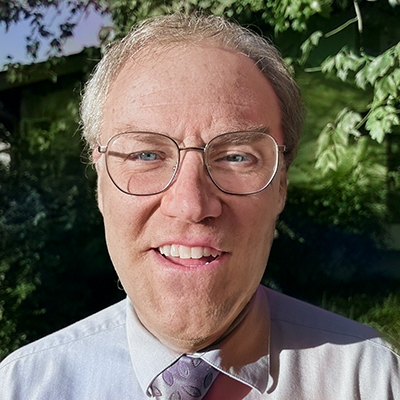
Graduate Student Mathematical Modeling Camp

Graduate Student Mathematical Modeling Camp
The GSMM Camp is a weeklong workshop directed towards interdisciplinary problem solving whose aim is graduate student education and career development. The GSMM Camp is designed to promote a broad range of problem-solving skills, including mathematical modeling and analysis, scientific computation, and critical assessment of solutions. The mathematical problems considered at the Camp are highly interdisciplinary in nature and are inspired by real problems that arise in industrial applications. Graduate and advanced undergraduate students work on the problems in teams, guided by an invited faculty mentor, so that scientific communication is an important and integral component of the work. As a result, the GSMM Camp exposes students to real-world problems of current scientific interest, and provides a valuable educational and career-enhancing experience outside of the traditional academic setting.
Nineteenth Annual Camp: June 20–23, 2024
The GSMM Camp operates hand in hand with the annual Mathematical Problems in Industry Workshop. The Camp runs during the week prior to the Workshop and the students and mentors are encouraged to attend the Workshop as well. Thus, the GSMM Camp provides an additional problem-solving experience for students as a warm-up prior to the workshop.
Funding is available so that most students accepted to the program will be reimbursed for reasonable travel and local expenses for both the Camp and MPI.
The GSMM Camp is an informal problem-solving workshop. On the first day of the Camp, the invited faculty mentors will present problems to the whole group. These problems, spanning a wide range of topics, are chosen to exercise and enhance the problem-solving skills of the attending graduate students. After the initial problem presentations, the graduate students break up into small groups, according to each student's problem preference, to work in teams with the help of the faculty mentors. Work on the problems proceeds in an informal setting for the remainder of the Camp. On the last day, summary presentations highlighting the work done are given by student representatives from each team.
All activities of the Camp take place on the campus of University of Delaware. Lodging for visiting graduate students will be provided in university housing and meals will be provided for all students and mentors. During the Camp, students and mentors will have access to campus computing, library and recreational facilities.
Advanced students who are actively pursuing a degree in some area of applied mathematics are invited to apply to GSMMC 2024. Interested students should complete the online application form. They should also have a signed letter of recommendation emailed to dedwards@udel.edu.
Student support for GSMMC 2024 is limited, so early applications are encouraged.
The selection will be based on academic background and interests as indicated in the application form, and on the letter of recommendation provided by a faculty sponsor. Women and students from underrepresented groups are especially encouraged to apply.
Applications must be completed by April 19, 2024 for full consideration, and successful applicants will be notified by early to mid May. Funded students will be reimbursed for reasonable travel and local expenses.
Successful applicants will be strongly encouraged to attend MPI 2024 and support will be provided to attend that meeting as well.
The Society for Industrial and Applied Mathematics (SIAM) supports students participating in the GSMM Camp and MPI Workshop through the James Crowley Fund for Student Support. We also thank UD’s Department of Mathematical Sciences and College of Arts and Sciences for their generous support.
Modeling spatial dependence of rods and cones in the retina
Daniel Anderson, George Mason University
The human retina is a thin, light-sensitive tissue at the back of the eye whose role is to convert light into electrochemical signals that get sent to the brain via the optic nerve; for healthy eyes, the result is visual recognition. For our purposes we shall think of the retina as composed of two types of photoreceptors -- rods and cones -- as well as an underlying retinal pigment epithelium (RPE). For humans, as well as primates such as Rhesus Monkeys, the rod and cone spatial distribution along the retina has been measured and differ significantly between these two photoreceptor populations. Also, recent data has shown how the photoreceptors outer segment (OS) length varies along the retina. Data for quantities such as RPE density and the thickness of the retina as a whole also exist. Recent mathematical models have begun to give predictions for the spatial dependence of photoreceptor OS thickness. The goal of this modeling project is to investigate these ideas and develop new models and solutions that may allow the incorporation of additional details such as RPE density and/or retinal thickness into photoreceptor OS length predictions. Opportunities for modeling using ordinary and partial differential equations, asymptotic approximation, and computation are likely part of this project.
The Image Deblurring Problem: Matrices, Wavelets, and Multilevel Methods
Malena Espanol, Arizona State University
In today's visually-centric world, the demand for high-quality images is ever-increasing, whether it is for medical imaging, surveillance, or digital photography. However, the process of capturing images is inherently prone to blurring due to various factors, such as motion during capture or imperfections in optical systems. The image deblurring problem lies at the heart of restoring these blurred images to their sharp, clear originals, presenting an exciting challenge for mathematicians. In this project, we will leverage tools and concepts from linear algebra, statistics, and optimization to produce new, efficient, and accurate algorithms. Furthermore, we will explore the use of wavelets and multilevel methods to speed up the process of restoring images.
Asymmetric division and modeling of interacting cell populations in the colonic crypt
Christopher Raymond, University of Delaware
Students will be exposed to:
- Population dynamics type modeling leading to a nonlinear system of ODEs.
- Nondimensionalization and scaling of models.
- Analysis of a nonlinear system of ODEs: finding stationary and periodic solutions and their stability
- Extensions to the model: PDEs, conservation laws, other ways to modify and extend the basic model
- Numerical methods for solution of the models using MATLAB
Camp Directors

Past GSMM Camp Abstracts
Below are the problems to be presented at the 2023 Graduate Student Mathematical Modeling Camp.
Modeling of Drying Process in Porous Media
Hangjie Ji, North Carolina State University
Solvent evaporation from the liquid-air interface naturally occurs in porous media saturated with particle-laden solutions. Such drying dynamics play a crucial role in environmental processes and engineering applications such as water resource management and industrial drying processes. For example, after a membrane filter (a thin layer of porous media) is employed to remove undesired particles from a fluid, one needs to dry the filter to reuse it. During the drying process, some particles get deposited on the internal structure of the porous media. Meanwhile, the evaporation rate from the media is significantly influenced by solvent properties, thermal effects, particle deposition, and media porosity. Understanding the interplay between the moving liquid/air interface and particle deposition is crucial in predicting the media structure after the filter is dried. Furthermore, this problem is multiscale in nature, requiring a pore-scale microscopic model to describe the evaporation from individual pores and a continuum model to account for the macroscopic evolution of membrane internal morphology during the drying process.
This project will start with an idealized pore-scale model to describe the drying process in porous media. The developed model should account for factors such as evaporation, particle deposition, and the pore geometry. Based on this model, we will explore the effects of pore geometry, temperature field, and initial particle concentration on the drying dynamics. The students will also be encouraged to extend their findings to a multiple-pore structure or a macroscopic continuum model. This session will prepare participants to better understand the context of filtration and drying in porous media and gain familiarity with modeling techniques (nondimensionalization of models and asymptotic analysis), basic ODE/PDE analysis, and numerical simulation.
Particle Filtering to Clarify Impure Models and Data
Peter Kramer, Rensselaer Polytechnic Institute
Predictions from structured dynamical models can be combined with emerging data in a process broadly referred to as ``filtering,'' when the reliabilities of each can be at least roughly characterized. As a guiding example, we can think about models of disease spread (say of the SIR or SEIR type) which are used alongside observed case counts as the disease outbreak is occurring. Discrepancies between the model and data can be due to missing or inadequately represented features of the model and/or errors in the observation process, and the filtering process attempts to reconcile these inconsistencies. Kalman filtering gives an efficient and rational solution when the dynamics are linear and both model and observational error can be treated as Gaussian noise uncorrelated in time. In more general settings, filtering approaches can be formulated mathematically in terms of Bayesian inference, and the question becomes how to implement these Bayesian updates in a computationally efficient manner. Particle filters, which here refer to a computational statistical methodology rather than a porous medium, are a popular class of approaches, in which the uncertainty in the dynamical state is characterized by a distribution of particles representing different possible states with certain probabilistic weights. These particles are to be given rules for how to update their state values and weights as new observations become available. These choices need to both be consistent with the statistical representation of uncertainty and with concerns of computational fidelity and cost.
The aim of this working group will be to gain familiarity with some particle filtering approaches by computational experiments on various kinetic models including models of disease spread. Students in this session will also be encouraged to apply the particle filters to dynamical models of their own interest. One outcome will be to see how standard particle filtering approaches that should work in principle can run into practical computational problems. This session will thereby prepare participants to better understand the background and context for particle flow.
Modeling and evaluating risk for fire from rare weather events
Manuchehr Aminian, Cal Poly Pomona
On December 30, 2021, there was a devastating in the greater Boulder area in Colorado, as the result of a fire carried by intense (70-100mph) winds propagating what would normally be a localized grass fire, jumping into urban areas and destroying over one thousand homes and various other property. This was surprising to many - and was understood to be the result of a unique combination of weather and climate circumstances; see the following for a longer explanation:
High Winds and Marshall Fire on December 30th, 2021
In the wake of this event, our (fake) insurance company wants to re-evaluate overall fire risk for a variety of geographic regions which accounts for potential events as the result of similar weather patterns to the Marshall fire, through some combination of mathematical modeling and data analysis/data-driven methods.
Broadly, we have two main tasks for participants:
1. Identify existing mathematical models which are "expressive" enough to both capture the weather effects seen during the Marshall Fire, and also capture "nominal" weather. If they do not exist, construct one. Ideally, the relative frequency of these "intense" events can reflect reality to some degree. While we prefer a smaller, more useful model, an existing kitchen-sink, black-box weather simulation code which participants can successfully explain is acceptable.
2. A ranking, scoring, or flagging of a geographic regions throughout the US based on their relative risk for events such as the Marshall Fire. Any approach here is valid, as long as it is well-explained. Aside from "plugging in" the model in part 1, purely data-driven methods (e.g. data analysis; feature extraction/selection, outlier detection, anomaly detection, etc) are also welcome, but (again) explainability is important.
Below are the problems to be presented at the 2022 Graduate Student Mathematical Modeling Camp.
Modeling the tradeoffs in publishing urban travel data sets
Manuchehr Aminian, Cal Poly Pomona
Geospatial travel data is enormously valuable for local governments to makeinformed decisions on urban planning, zoning, fiscal policy, and so on. When governments collect such data using taxpayer money, there are expectations for (a) transparency in data and data collection, (b) privacy of participants involved indata collection, (c) utility of data to make informed decisions. These three priorities are often at odds with one another. The project sponsor wants us to mathematically model these tradeoffs, suggest approaches to privacy of individuals, and do a risk analysis of a hypothetical malicious actor seeking to discover details of individuals in the data. The sponsor would like these applied to data from a large travel data set from the Minneapolis/St. Paul metropolitan area during 2018-2019.
Cloudy with a chance of snow: The life of a snowflake in a cloud microphysics model
Valeria Barra, California Institute of Technology
Clouds can be very fascinating and romantic to stare at, but they provide great challenges from a mathematical and numerical modeling point of view. In fact, clouds currently are one of the greatest sources of uncertainty in climate forecasts. One of the reasons why they are so difficult to capture in current numerical models is the extreme range of scales involved: from processes happening on the length scales of individual cloud droplets, to the large-scale eddies driving the air circulation of a cloudy field. It is important to keep track of the microscopic properties of cloud particles in order to properly resolve, for example, the physics of rain or snow formation. On the other hand, it is also very important to keep the simulation computationally affordable. How to make things simple without oversimplifying?
We will look at this question from the point of view of a snowflake. Snowflake crystals come in many different shapes and sizes. This can, inturn, affect their growth rates, collision rates and their sedimentation rates. Although these are all very important aspects to take into account, typically, current cloud models used in the climate andatmospheric science communities can only afford to predict cumulative quantities, such as the total mass of snow produced in a cloud.
This project will start by considering a simple, idealized model of the shape of a snowflake. Building upon this idealized model, we will then consider possible variations or extensions to make the model more realistic. The main goal for this workshop will be to come up with possible mathematical models that are detailed enough to capture the different possible snowflake shapes, but simple enough that they can be integrated into a more complex cloud model, and therefore be useful for climate predictions. Some additional questions that we could answer during this workshop can then help us build our understanding of how precipitation rates can be affected by different snowflake geometries, and how we could potentially include more complexity.
Asymmetric division and modeling of interacting cell populations in the colonic crypt
Christopher Raymond, University of Delaware
Students will be exposed to:
- Population dynamics type modeling leading to a nonlinear system of ODEs.
- Nondimensionalization and scaling of models.
- Analysis of a nonlinear system of ODEs: finding stationary and periodic solutions and their stability
- Extensions to the model: PDEs, conservation laws, other ways to modify and extend the basic model
- Numerical methods for solution of the models using MATLAB
Here are the problems presented at the 2021 Graduate Student Mathematical Modeling Camp, as well as summary reports of the work accomplished.
Ecological modeling of host-parasitoid population dynamics
Brooks Emerick, Kutztown University
Abstract: Host-parasitoid interactions make up an important class of consumer resource dynamics. A parasitoid is an organism that spends most of its life cycle attached to or inside the host. Unlike an actual parasite, the parasitoid eventually kills the host. During a particular season of the year, known as the vulnerable period, the parasitoid injects eggs into the host larvae. Parasitoid larvae, then, emerge from the host, effectively killing it. Discrete-time models are usually employed to simulate host-parasitoid interactions because reproduction occurs at the same fixed date every year. Early models of this phenomenon include the discrete-time Nicholson-Bailey model, which is known to be unstable i.e. coexistence is impossible. More recent models take advantage of a hybrid technique that uses continuous dynamics to model the vulnerable period so that stabilizing characteristics can be mechanistically incorporated. During this camp, we'll review the basic discrete models, explore various dynamic models of the vulnerable period, and study the semi-discrete framework. Along the way, we'll develop the model building process and analyze each model with appropriate linear stability analysis. Ultimately, by the end of the camp, students will be comfortable with the host-parasitoid modeling process and will be able to explore sophisticated modeling scenarios, potentially discovering new models that provide biological insight into the intricate dynamics of the host-parasitoid interaction.
Water flow through plants and its impact on climate
Valeria Barra, California Institute of Technology
To understand the impact of greenhouse gas emissions, it is important to constrain carbon uptake by the land surface, which is currently a big uncertainty in future climate predictions. To do this, we need to understand the terrestrial water cycle, and especially how plants use water. In climate models that simulate the entire Earth system (comprising the atmosphere, ocean, land and ice masses) plants can serve as an important link between the land and the atmosphere. Hence, plant hydraulics, which studies water transport processes through roots, trunks, stems, and leaves, becomes a key link between different modules in modern climate models. Accurately modeling this process with equations based on Darcy's Law for water flow in a porous medium helps constrain photosynthesis and evapotranspiration (also crucial for temperature extremes and precipitation predictions).In this workshop, we present a simple root-stem-leaf plant model that represents the water flow through plants, allowing water exchange between plants and soil. Our goal for the camp will be to extend the simple model provided, either by increasing the accuracy of the modeled plant response to drought or by taking into account different plant geometries. If time allows it, we will investigate different parameter choices or systemic changes to address several open questions: Up to what height can plants grow with this model? How does the hydraulic conductivity affect the decay of plants?
Mathematical Models and Simulations of Recongurable Flow Networks: Erosion, Deposition, Filtration and Growth
Pejman Sanaei, New York Institute of Technology
Here are the problems presented at the 2019 Graduate Student Mathematical Modeling Camp, as well as summary reports of the work accomplished.
Drug Delivery in Contact Lenses
Daniel Anderson, George Mason University
Abstract: Ophthalmic drugs are commonly delivered via eye drops. Drainage out of the eye during a blink and the resupply of fresh tears are among the issues that limit the residence timeand effectiveness of the drug in the eye. The use of contact lenses is an alternative means for sustained drug delivery for the treatment of chronic and acute eye disorders.Soft contact lenses are made out of hydrogels and the understanding of diffusion of chemicals through these materials along with transport mechanisms of the drugin the tear film environment are fundamental to the success of these types of treatments. In this project, we explore mathematical models for drug delivery from a contact lens during wear and aim to develop predictive models for drug delivery in contact lens and tear films.
Cutting with Water: From Fish to Fracking
Richard Moore, New Jersey Institute of Technology
We’ve all seen how water can cut through mountains with its erosive power and crack rock when pumped underground at high pressure. We’re perhaps less familiar with water jets used as a precision cutting tool, employed regularly in the food and textile industries. Abrasive water jets, with small particles of garnet in the stream, can cut hard materials such as glass and metal. They are competitive with other precision machine tools such as laser, plasma, and wire EDM cutters but don’t generate a heat-affected zone in the material.
There are some challenges with abrasive water jets, however. Depending on the traverse speed of the cutter, striations can form on the cut face, a blank region can be left in the sample, and the kerf (i.e., the gap left by the cut) can develop an undesired internal angle (bevel).
Our goal for the camp is to understand the basic operation of the abrasive water jet and the mechanisms underlying the problems described above. Time permitting, we’ll propose some parameter choices or procedural changes to address the problems.
Flow and Fouling in Elastic Membrane Filters
Pejman Sanaei, New York University
Abstract: Membrane filters are used in various industrial engineering processes and one of the most significant applications is water purification, where target particles, colloids and macromolecules, are removed from the water flow by applying microfiltration. Hence mathematical models to predict their efficacy are potentially very useful, as such models can suggest design modifications to improve filter performance and lifetime. Many models have been proposed to describe particle capture by membrane filters and the associated fluid dynamics, but most of such models are based on a very simple structure in which the pores of the membrane are assumed to be simple circularly cylindrical tubes spanning the depth of the membrane. Real membranes used in applications can have much more complex internal structure, with interconnected pores that may branch and bifurcate, and pore-size variation across the membrane. However, during the filtration process, membrane fouling due to the block of large particles and deposition of small particles occur and decreases the membrane performance. Thus, the membrane’s permeability decreases as the filtration progresses. Two driving mechanisms can be considered an here: (i) constant pressure drop across the membrane specified; and (ii) constant flux through the membrane specified. In the former case the flux will decrease in time as the membrane becomes fouled; in the latter, the pressure drop required to sustain the constant flux will rise as fouling occurs. Considering elasticity to sub-branches in constant flux scenario, in some stage of filtration process, the radius of pores may tend to expand due to the effect of high pressure on the elastic sub-branches, which is not negligible.


